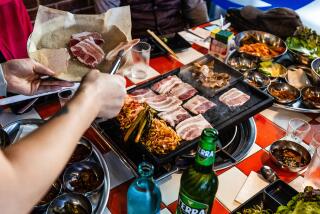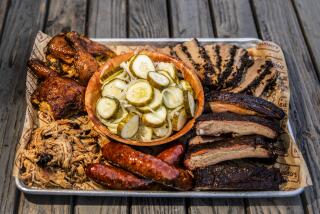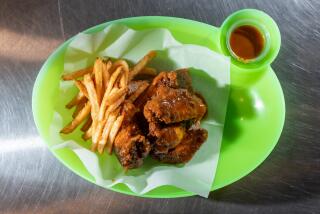This Brisket’s Smokin’
- Share via
First, the good news about Sonny Bryan’s Smokehouse. If you land at Love Field in Dallas, you can be at Sonny Bryan’s in five minutes. That’s enough time to chow down on some of the most righteous barbecue in Texas before you catch your next flight.
Now the bad news. Unless you arrive before 1 p.m., the restaurant will probably be closed. That’s because the original Sonny Bryan’s stays open only as long as it takes to sell out of the 30 or so beef briskets served daily. And given the popularity of Bryan’s brisket, it’s usually gone by 1 p.m.
In a state known for its barbecue (according to the Texas Restaurant Assn., the Lone Star State boasts more than 3,800 barbecue joints and restaurants), Sonny Bryan remains one of the most legendary pit masters, a man who served moguls and movie stars (but only when he felt like it) and who once carved 250 briskets in a single day. This month Sonny Bryan’s celebrates its 40th anniversary.
I never met Bryan, who retired in 1989 and died a few years later. But the staff speaks of him so vividly, I feel I almost know him. I see him as people did when the black-and-white photograph in the restaurant was taken in the early 1960s--a crisp white paper cap on his head, smile lines crinkling at the corners of his eyes and proudly holding a tray of the brisket that made him famous.
It is awesome stuff. Smoky as a fireplace, as succulent as stew and tender enough to pull apart with my fingers. No, it’s not undercooked: The pinkish-red tinge around the edge of the meat is the smoke ring, a naturally occurring band of color found in meats that are smoked for a long time. The sauce comes in a beer bottle. It is tomato-y and tart with vinegar and not in the least bit sweet. That’s real smoke flavor you taste. The sauce is actually cooked in the pit, as are the smoky baked beans.
The late Sonny Bryan acquired his love and knowledge of barbecue from his grandfather Elijah, who opened a restaurant in the Oak Cliff area of Dallas in 1910. (The horseshoe that hung in Elijah’s restaurant can still be seen in Sonny Bryan’s.) His father, Red Bryan, followed suit in 1936, as did Sonny. But in 1957, when Oak Cliff decided to ban the sale of alcohol, Sonny left Oak Cliff to open a barbecue joint on Inwood Road. “I can’t serve barbecue without beer,” said Sonny.
The original Sonny’s wasn’t much to look at (it still isn’t): a rough and tumble, beige, one-story, cinder-block building located next to a Salvation Army Thrift Center.
Somewhere along the line, Sonny installed a dining area with a row of windows and 20 ancient wooden school desks. Seating is very much a matter of first-come, first-served, as celebrities have learned to their consternation.
A few years back, two stretch limos arrived at Sonny’s and a man came in and said, “I have Sylvester Stallone in the car; I need 20 seats.”
Sonny looked over and said, “You’re welcome to wait for ‘em or eat in the parking lot. I can’t ask my regular customers to move.”
Stallone ate barbecue elsewhere.
In 1989, Sonny retired, selling his recipes and restaurant to a group of investors headed by Mike Meehan, who began opening other restaurants. Today there are 11 Sonny Bryan’s in Texas, with plans underway for further expansion and retail products. I’ve eaten at some of the new restaurants and they’re perfectly respectable.
But you’ll find me making a mad dash between planes from Love Field to the original Sonny Bryan’s to eat brisket made with 40 years of smoke and dedication.
Barbecued brisket is both one of the easiest and one of the most challenging recipes in the world of barbecue. Easy, because it requires only one main ingredient--brisket (even the rub is optional); difficult, because pit masters spend years learning the right combination of smoke (lots), heat (low) and time (measured in half-days rather than hours) to transform one of the toughest, most ornery parts of the steer into tender, meaty perfection.
Over the years, I’ve found that two things help above all: Choosing the right cut of brisket, namely an untrimmed brisket with a thick sheath of fat, and cooking the brisket in a shallow pan. The latter keeps the juices from dripping onto the fire and the meat from drying out, while allowing for maximum smoke penetration from the top.
TEXAS-STYLE BRISKET
1 (5- to 6-pound) beef brisket with thick layer of fat
1 tablespoon kosher salt
1 tablespoon chili powder
2 teaspoons sugar
1 teaspoon freshly ground black pepper
1 teaspoon ground cumin
6 to 8 cups hickory or mesquite chips or chunks, soaked in cold water 1 hour
Use a partially trimmed brisket with at least a 1/4-inch-thick layer of fat, a cut that you can find at the supermarket weighing 5 to 6 pounds. Do not attempt this recipe with a fatless, trimmed, 2-pound brisket; it will turn out too dry. Get ready for some of the best barbecue you’ve ever tasted.
Wash brisket and pat dry.
Combine kosher salt, chili powder, sugar, pepper and cumin in bowl and toss with fingers to mix. Rub mixture into brisket on all sides. Wrap brisket in plastic wrap and marinate in refrigerator at least 4 hours or overnight.
Set up grill up for indirect cooking (see Cook’s Tips), placing drip pan in center.
Place brisket, fat side up, in aluminum foil pan (or make pan with sheet of heavy-duty foil). Place brisket in center of grate, away from heat. Cover grill.
Smoke brisket until tender enough to shred with fingers, 6 to 8 hours. Cooking time will depend on size of brisket and heat of grill. If using charcoal, add 20 fresh coals, 10 per side per hour and 1 cup chips. With gas, just be sure that you start with a full tank.
Remove brisket pan from grill and let cool 15 minutes. Transfer brisket to cutting board and thinly slice across grain. Transfer sliced meat to platter and pour pan juices on top.
10 to 15 servings. Each of 15 servings:
410 calories; 555 mg sodium; 92 mg cholesterol; 35 grams fat; 1 gram carbohydrates; 21 grams protein; 0.13 gram fiber.
(BEGIN TEXT OF INFOBOX / INFOGRAPHIC)
CHEF’s Tips
To set up charcoal grill for indirect cooking, light coals (about 50) and place them in side baskets if your grill comes with them or rake them into 2 piles at opposite sides of grill. Place drip pan between coals. Let coals burn down to glowing embers and adjust vents to obtain a 275- to 300-degree temperature. Toss 1/4 of wood chips on coals. Cook brisket in center of grill.
To set up gas grill for indirect cooking, light front and rear burners of grill or light burners on one side. Place all the wood chips in smoker pan and preheat grill to high. When smoke appears, reduce heat to medium-low, then place brisket in center of grate or on opposite side from burners, away from heat.
More to Read
Sign up for The Wild
We’ll help you find the best places to hike, bike and run, as well as the perfect silent spots for meditation and yoga.
You may occasionally receive promotional content from the Los Angeles Times.






